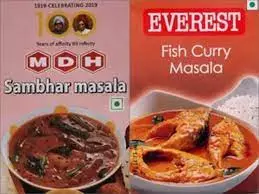
Ethylene oxide use controversy: Government takes action against Everest, MDH
The Indian government has ramped up inspections in spice exporting companies Everest and MDH and have suggested corrective measures for the use of ethylene oxide, said ministry of commerce officials

In the ongoing controversy over the discovery of ethylene oxide in certain Indian spice products, the Indian government has said that it has taken action against spice-exporters Everest and MDH.
These two big companies were recenty found violating rules involving ethylene oxide residue in some of their products in Singapore and Hong Kong. This led to recalls and bans of specific batches of their products in these markets.
According to a report in Mint, senior officials in the ministry of commerce told the business daily that the government has taken action against these companies after elevated levels of ethylene oxide, a cancer-causing chemical, was found in certain batches of their products exported to Singapore and Hong Kong.
The government has ramped up inspections and suggested corrective measures to these companies. The corrective measures were suggested based on the periodic sampling done by the Spices Board of India, the nodal agency for spice exports.
The government has also held three consultations with the industry to ensure their practices are in sync with international standards, pointed out a senior official in the report.
The food industry is also keen to ensure that it is complying with the maximum permissible limit criteria, said the report.
Compulsory testing
Earlier this month, the Spices Board of India, also made ethylene oxide testing compulsory for all spices exported to Hong Kong and Singapore for a period of six months. A decision that will be reviewed again later.
Guidelines were issued by the government to all exporters to avoid ethylene oxide contamination during sourcing, packaging, transportation and testing.
The Food Safety and Standards Authority of India is also collecting samples and testing them on a large scale as well.
Use of ethylene oxide
This chemical is often used in the food industry as a steriliser to reduce the bacterial load, yeast, and mould. However, it can cause health risks, including cancer if the residue levels are beyond the permissible levels
However, every country has a different permissible level. For instance, the maximum residue limit for ethylene oxide in the European Union is 0.02-0.1 mg per kg, while that of United States and Canada is 7 mg per kg. Hong Kong completely prohibits ethylene oxide in food products, while Singapore has a limit of 50 parts per million.
According to another ministry of commerce official, the challenge for exporters it that there is no standardisation of ethylene oxide limits or testing norms globally.
India's thriving spice exports
However, despite these setbacks, the failure rate of Indian spices is at 0.2 per cent, said the report quoting the official. This is much better than the international average and significantly lower than the 0.73 per cent rejection rate of food consignments entering India.
Moreover, Indian spice exports are doing well, for in FY24, spice exports from India increased to $4.25 billion from $3.76 billion the previous year.
India is one of the world's largest producers and exporters of spices like black pepper, cardamom, chili, turmeric, and cumin.

